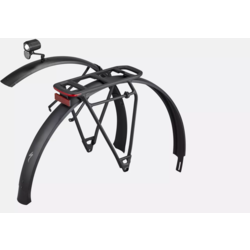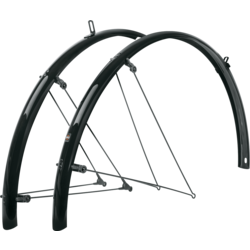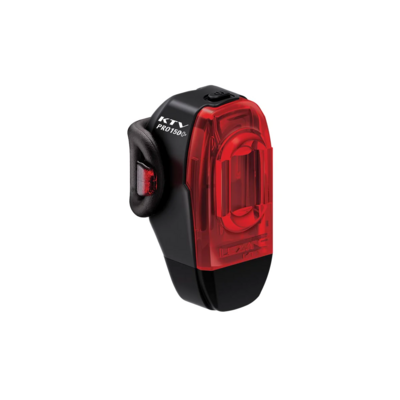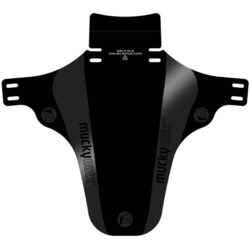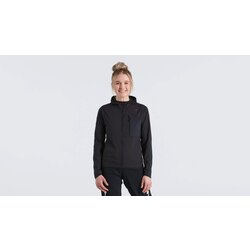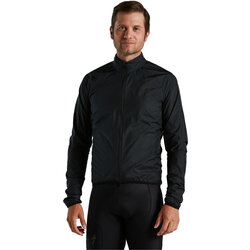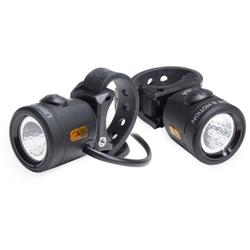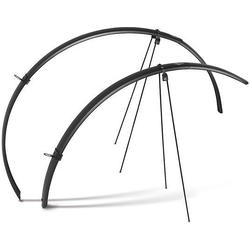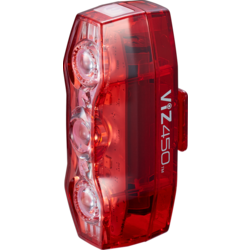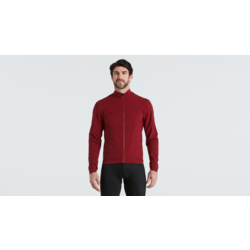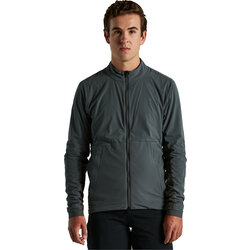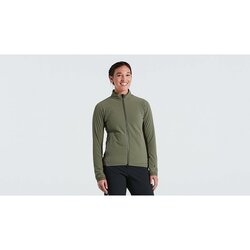"There's no such thing as bad weather for cycling -- only inadequate clothing."
With the right gear you can ride in cold, rain or wind and still arrive at your destination warm, dry & comfy!
"The Right Stuff" makes all the difference. A conventional raincoat offers some protection, but there's nothing like a complete setup designed and engineered to keep you dry & safe on the bike.
& Be Seen
Let everyone know you're on the road! Heavy rain & headlight glare reduce motorists' vision, so it's critical to light up your bike with a combination of bright lights, reflectors, and visible clothing.
Leading light manufacturers invest heavily in R&D to bring you the best protection possible. Use the best white light you can find in front, red on the rear (L&M's unique SafePulse beam pattern has the most science behind it), and amber on the sides or MonkeyLights in the wheels if you wanna go 'whole hog'.
And they're not just for nighttime: more and more riders are getting brighter lights (like Blackburn's "Dayblazer" series) designed to keep drivers aware of your presence day & night, rain or shine.
Make Sure You Can See
In low light, clear or yellow lenses give you the best visibility and eye protection. In the rain, normal sunglasses cut out too much light and can make road obstacles hard to see.
A good visor on your helmet (either built in or an add-on model) will shield some of the rain & spray from hitting your glasses. Using an anti-fog product (like Rain-X, or something from our snow department) will help keep your vision sharp & clear!
And of course, lighting up your bike is key: powerful headlights help you see at night, and a variety of colorful flashers aimed in the appropriate directions help drivers see you in weather that impairs their vision.
The right clothes!
Keep your core warm; a waterproof jacket designed for on-bike wear (with a dropped tail in the back, for one thing) is critical for rainy conditions. Always wear wool socks, and try a wicking base layer for longer rides in cold, wet weather.
A complete rainsuit also includes cycling rain pants, shoe covers, a helmet cover and full fingered water- & wind-resistant gloves. Your body sweats when you ride, so choose cycling apparel made with waterproof/breathable fabrics and adjustable venting or you'll arrive wet from the inside, not the outside.
Visibility counts here too: wear clothing designed to give drivers a chance to see you. Neon colors by day and reflectors by night really can help - so check our wide selection of jackets, vests, sashes, leg bands & more that commuters can slip on & off quickly.
The right gear!
Fenders are not foolishness. If you plan on riding for any length of time, or with others, install fenders on both wheels. It will quadruple your comfort factor and keep your vision crystal clear. It's one of the unspoken rules that on rainy-day group rides you should never show up without fenders.
Clip-on fenders give partial coverage, preventing "freshman stripe" and a mud splattered face. But for real protection (for yourself, and the rider/s behind you) choose full-length fender sets (it's easier if your frame & fork feature eyelets designed for that purpose, but we have models to fit bikes without those too).
The best fenders are really long and have mudflaps built in - we've seen homemade flaps too - anything you can do to keep the spray lower will help your ride. Combine those with a head-to-toe cycling-specific rain suit, and you're good for any weather!
Rainbow Patches & Puddles
Pavement is slickest and most dangerous just after the rain has begun. Rain floats the oil buildup in the asphalt (from cars, bikes... and much of it from tomatoes, around here!) to rise to the surface, creating treacherous oil slicks once a year.
Keep an eye out for little rainbow-edged puddles, indicating oil slicks. Never brake or corner in or near these. Make an effort to notice metal surfaces such as manhole covers or steel-grid bridge decks, painted traffic markings, or wet leaves, as they all become very slick when wet.
As fun as it may be to bash through puddles, avoid them. More than one cyclist has broken a wheel on a submerged pothole or other obstacle!
Watch Those Corners
Cornering in the rain can be tricky. To maximize safety, shift as much of your weight onto the outside pedal as possible. Use body English to keep the bike more upright when cornering, leaning your body more than the bike. By doing this, you will be able to corner with a reasonable amount of speed, as the body will tend to remain balanced over the bike when the tires slide over painted lines and unseen oil patches.

